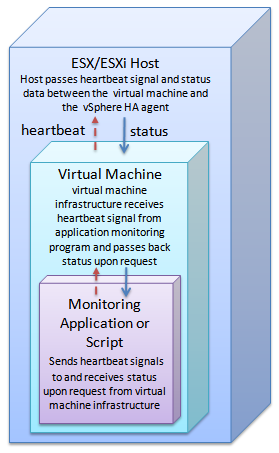The vSphere High Availability (HA) feature for ESXi hosts in a cluster provides protection for a guest OS and applications running in a virtual machine by restarting the virtual machine if a guest OS or application failure occurs. The HA feature provides this reset capability through two different mechanisms:
|
1
|
|
2
|
Heartbeat issued by a program that uses the HA Application Monitoring SDK to communicate with the VMware Tools process and the vSphere HA agent, known as Application Monitoring. This mechanism involves local monitoring by the program, thus avoiding the overhead of sending messages to and from vCenter Server.
|
Heartbeat and Status Signals depicts the monitoring and reset capability of host and virtual machine.
Using the HA Application Monitoring SDK, developers can write application monitoring programs in the C or C++ language.
The application monitoring program sends an enable request to start the monitoring, followed by a heartbeat signal. The vSphere infrastructure passes the signal up from your HA application monitoring program to the virtual machine, and then to the ESXi host. The HA monitoring agent will reset the virtual machine if the application monitoring program stops sending a heartbeat signal.
For more information about vSphere HA and application monitoring, see the vSphere Availability guide in the vSphere Documentation Center.
